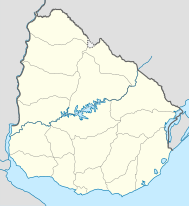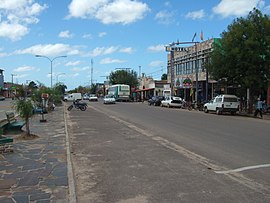Chuy
| Chuy | ||
|---|---|---|
|
Coordinates: 33 ° 42 ′ S , 53 ° 27 ′ W Chuy on the map of Uruguay
|
||
| Basic data | ||
| Country |
|
|
| Department | Rocha | |
| City foundation | 1888 | |
| Residents | 9675 (2011) | |
| City insignia | ||
| Detailed data | ||
| Population density | 87.3 inhabitants / km 2 | |
| height | 2 m | |
| Post Code | 27100 | |
| prefix | +598 4474 | |
| City Presidency | Mary Urse | |
| Website | ||
| Avenida Brasil in Chuy, beyond the median on the left: Avenida Uruguai (Chuí, Brazil) | ||
Chuy is a small town in the South American state of Uruguay .
Geography, economy, infrastructure
Chuy is located in the east of the country in the Rocha department, right on the border with Brazil. Together with the somewhat smaller municipality of Chuí in the Brazilian state of Rio Grande do Sul , it forms a border town with correspondingly brisk trade. The Ruta 9 highway from Montevideo to Rio Grande in Brazil runs through the city and becomes the BR-471 at the border. The street Calle Internacional runs on the border between the two districts, half of which belongs to Uruguay (Avenida Brasil) and the other half to Brazil (Avenida Uruguai) . Chuy is only 15 km from the Atlantic Ocean; in the northern hinterland is the Lagoa Mirim at a similar distance . Besides trade, tourism is the city's second economic mainstay. Numerous duty-free shops offer Brazilian travelers spirits, cosmetics, clothing, luxury items and the like. Ä. on. There is also a casino in Chuy, Uruguay ; Gambling is not allowed on the Brazilian side .
history
According to most experts, the name Chuy comes from the Tupí-Guaraní languages , which were spoken in the region before the European discovery and settlement. At first it only referred to the small stream ( Arroyo Chuy ), on whose banks the village later emerged. In recent years anthropologists have found various grave sites and other evidence of an early, relatively highly developed culture in the area, whose members lived in the area around the year 500 BC. Inhabited, discovered. Among other things, they made their living from hunting and fishing in the Atlantic and the nearby lagoons and were already proficient in pottery.
In February or March 1502 an expedition under Amerigo Vespucci passed the mouth of the Arroyo Chuy for the first time ; on behalf of the Portuguese Crown, she explored the previously completely unknown coast of South America (which Spain was entitled to in this area according to the Treaty of Tordesillas of 1494). A permanent settlement of European settlers in the region was not to begin until much later. At the beginning of the 17th century, Uruguay introduced cattle breeding and in the decades that followed, Portugal and Spain established several cities and fortresses in the region to safeguard their interests. With the Treaties of Madrid (1750) and San Ildefonso (1777), Portugal and Spain finally marked the mutual border of their colonial possessions in South America; the Chuy area thus became a borderland. Around 1751, the governor of Montevideo had various military border posts built in strategic locations along the border with Brazil, one of which was La guardia del Chuy . The Portuguese side also set up a guard on the Chuy. The most important functions of the border stations during this period included the fight against smuggling and the safety of settlers and travelers in the region.
A few years after the establishment of the border post, civilian residents also settled at the military station for the first time; a map from 1775 shows Chuy as a village for the first time. During the 19th century, livestock breeding continued to grow in the region and new estancias sprang up on both the Uruguayan and Brazilian sides of the border . The more intensive use and denser settlement of the area meant that in the middle of the century the state border in the Chuy area was precisely measured for the first time and marked with boundary stones. A general store ( pulpería ), first recorded in a plan from 1861, established Chuys as a trading place that still exists today. The import of goods from Brazil by local merchants also became more and more important over the next few years. The founding of the first school during this time underscores Chuy's increasing central role. From 1872 a telegraph line ran between Montevideo and Brazil through the town. In 1879 Chuy received a court and the following year a customs office. In 1888 the growing village was officially elevated to a parish by the higher authorities.
After Chuy's development had temporarily stagnated in the early 20th century, various new buildings were built again in the 1930s, including the town's first petrol station, which supplied the increasing number of passing and local drivers. During this time, Chuy also had his own local newspaper and an outpatient clinic . At that time tourism also slowly gained in importance; Chuy was already connected to the bus network and served as a gateway to the beaches on the nearby Atlantic coast. According to official records, about 1,300 people lived in the community in 1936. In the mid-1940s, the trunk road ( Ruta 9 ) from Montevideo to Chuy was completed; from then on, buses drove daily from the capital to the border town and vice versa. Important milestones in the development in the 1950s were the construction of the public drinking water network and the establishment of a grammar school as well as the construction of a Catholic chapel; In 1956 Chuy already had 2500 inhabitants. A further stage in the dynamic development of the place was the elevation to the market community in 1961. Since the 1960s, more Arab and Asian traders settled in Chuy; they are now an important factor in the local economy.
City administration
Mayoress ( Alcalde ) of Chuy is Mary Urse .
Residents
Its population was 9,675 at the last census in 2011, of which 4,608 were male and 5,067 were female.
| year | Residents |
|---|---|
| 1963 | 2,881 |
| 1975 | 4,521 |
| 1985 | 8,257 |
| 1996 | 9,804 |
| 2004 | 10,401 |
| 2011 | 9,675 |
Source:
sons and daughters of the town
- Lucas Rodríguez (* 1993), football player
Web links
- Official portal of the city Spanish
- City map of Chuy (PDF; 111 kB)
- Chuy on the site of the Intendencia des Departamento Rocha
Individual evidence
- ↑ "MUNICIPIOS DE URUGUAY" on the website of the Uruguayan Congress of Directors ( Memento of March 8, 2012 in the Internet Archive )
- ↑ Statistical data from the Instituto Nacional de Estadística de Uruguay , accessed on September 23, 2012
- ↑ Statistical data of the Instituto Nacional de Estadística de Uruguay 1963-1996 (DOC file; 172 kB)
- ↑ Statistical data of the Instituto Nacional de Estadística de Uruguay (PDF file; 628 kB)



